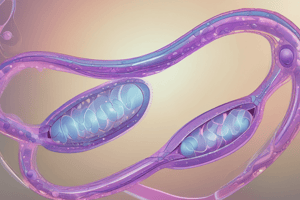Podcast
Questions and Answers
What is the purpose of meiosis in human reproduction?
What is the purpose of meiosis in human reproduction?
- To increase the number of chromosomes in the gametes.
- To create diploid gametes with the full set of chromosomes.
- To create haploid gametes with half the number of chromosomes. (correct)
- To create genetically identical copies of somatic cells.
What is the difference between spermatogenesis and oogenesis?
What is the difference between spermatogenesis and oogenesis?
- Spermatogenesis produces sperm continuously throughout life, while oogenesis produces ova only during puberty. (correct)
- Spermatogenesis occurs in the ovaries, while oogenesis occurs in the testes.
- Spermatogenesis produces diploid sperm cells, while oogenesis produces haploid ova.
- Spermatogenesis involves two rounds of meiosis, while oogenesis involves only one round.
If a somatic cell has 46 chromosomes, how many chromosomes would a gamete from that organism have?
If a somatic cell has 46 chromosomes, how many chromosomes would a gamete from that organism have?
- 46
- 23 (correct)
- 12
- 92
Which of the following is NOT a characteristic of meiosis?
Which of the following is NOT a characteristic of meiosis?
Which of the following is an example of a haploid cell?
Which of the following is an example of a haploid cell?
Which process is responsible for the growth and development of a zygote into an embryo?
Which process is responsible for the growth and development of a zygote into an embryo?
What is the outcome of fertilization?
What is the outcome of fertilization?
Why is it essential for meiosis to halve the number of chromosomes in gametes?
Why is it essential for meiosis to halve the number of chromosomes in gametes?
How does the process of meiosis contribute to genetic diversity in offspring?
How does the process of meiosis contribute to genetic diversity in offspring?
Which of the following structures is responsible for producing sperm cells in a male?
Which of the following structures is responsible for producing sperm cells in a male?
Flashcards
Gamete
Gamete
A sex cell containing half the number of chromosomes of body cells.
Study Notes
Human Reproductive Systems
- Sexual reproduction in humans involves the production of gametes (sex cells)
- In males, sperm are produced in the testes
- In females, ova (eggs) are produced in the ovaries
- Gametes contain half the number of chromosomes as other body cells, they are haploid
- Other body cells are diploid, containing two sets of chromosomes
- Meiosis is a special type of cell division that reduces the chromosome number by half
- Meiosis produces haploid gametes from diploid cells
- Mitosis is the process of cell division that results in two identical diploid daughter cells
Human Gamete Production
- Sperm production occurs in the seminiferous tubules of the testes
- This process continuously produces new sperm throughout a man's life
- In females, ova are produced in the ovaries, but the supply is limited
- Females are born with a set number of ova, decreasing over time
- When a female ovulates, an ovum is released
- A female can produce an ovum only after meiosis occurs after a sperm cell penetrates the protective layer around the ovum
- Fertilization occurs when a haploid sperm and a haploid ovum fuse
- The resulting zygote is a diploid cell with a complete set of chromosomes.
Meiosis
- Meiosis is a two-stage process resulting in four daughter cells
- Meiosis I and Meiosis II occur in sequence
- In Meiosis I, homologous chromosomes pair up and exchange genetic material (crossing over)
- Sister chromatids separate in meiosis II
Half of Genetic Material from Each Parent
- Each parent contributes half of the genetic material to their offspring
- This ensures genetic diversity
- Each child receives a unique combination of genes from both parents
Studying That Suits You
Use AI to generate personalized quizzes and flashcards to suit your learning preferences.




